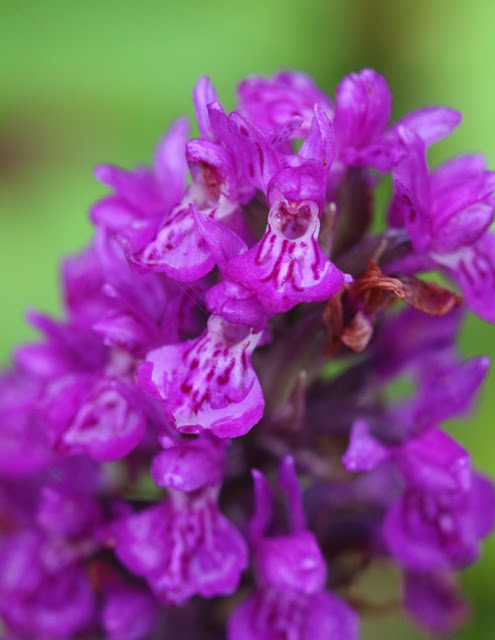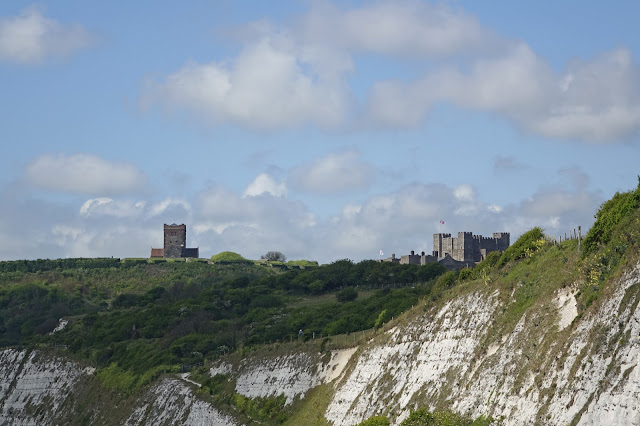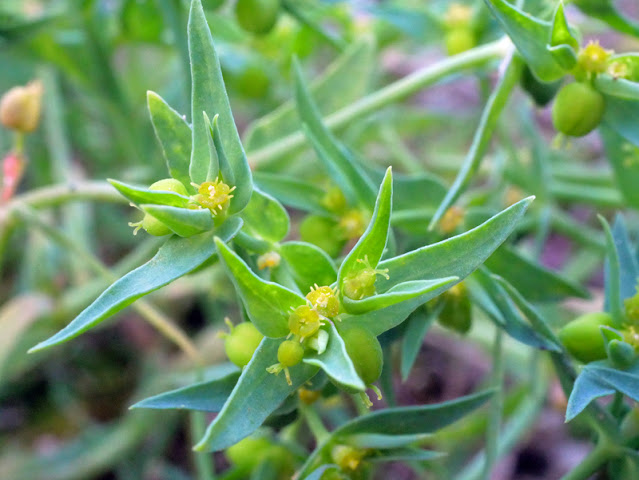Anglesey Adventures - Newborough Warren 29/0617
After a couple of days exploring the mainland, we set off to Newborough Warren back on Anglesey. This is home to many special plants and I hoped to find some today.
It wasn't a long drive to Newborough, but it felt quite remote being in the extreme South of the island. On entering the car park I was immediately taken by the huge amount of common wildflowers there. Wildflowers surrounded the car park rather than mowed grass, commendable management by the owners. The weather was reasonable as well, overcast but dry, though rain was forecast.
Close to the car park on the edge of the pine plantation were a few Northern Marsh Orchids.
This is species I am unfamiliar with being from the South, and there appears to be as much variation on these as I usually see on Southern Marsh Orchids.
Dactylorhiza purpurella
Another beautiful orchid caught my eye and I can't work out if it's a Common Spotted or a Heath Spotted Orchid, probably the former, though the side lobes of the lower petals are winged, much like the Heath Spotted.
Dactylorhiza fucshii or
D. maculata
As I carried on away from the car park, I found some umbellifers flowering, these were Rough Chervil. They can all look very similar but these have purple marks on the stems and are very rough to the touch.
Chaerophyllum temulum
I left the forest canopy and walked along a path along the back of the sandy dunes. This area had a much more diverse flora with the bright pink beacons of Pyramidal Orchids making them stand out from the crowd.
Anacamptis pyramidalis
I was rather surprised to find Sea Rocket here. I usually find it close to the sea which distributes its seeds. This path was over 100m from the sea behind large vegetated dunes. Perhpas it was sown from bird droppings or the seeds stuck in a walkers boot ending up here?
Cakile maritima
There were numerous stands of the fine looking Sea Spurge, a rare plant in the South East of England, I don't know its status here, but nice to see.
It's easy to confuse this (and Wood Spurge) with Portland Spurge, a much rarer form found in similar locations. However, Portland Spurge flowers in early Spring, so if you find one flowering in June, it isn't Portland Spurge.
Euphorbia paralias
I was very pleasantly surprised to find a lone Bee Orchid still flowering on the dunes.
They've gone over by now in most places and I suspect this is the last one to be found flowering here as well.
As you can see it had started drizzling again.
Ophrys apifera
Here and there were these beautiful Common Evening Primroses. There are several species they could be, but I took photographs of all parts of the flower and plant, so could properly identify it later.
Oenothera biennis
The scant soil on the dunes encouraged low growing plants like this Haresfoot Clover.
Tiny white pea flowers are hidden under the raindrops.
Trifolium arvense
There were a few poppies around, but this one looked different, mainly because it was more orange than red. A closer look at a gone to seed stem showed it to be Long headed Poppy which has smooth but elongated seed heads.
Assuming it's not a single plant, break a stem to see the juice as there is a Yellow-juiced Poppy with the same type of seed heads.
Papaver dubium
Under the trees to my left were several of these big, tall plants. Fortunately I had seen the species before so could immediately identify it as Common Valerian.
However, with this one I could identify it to sub species level as I had good photos of the leaves as well.
Valeriana officinalis subsp sambucifolia
Here's a close up of the flower head.
I was rather hoping to find a Dune Helleborine in flower. However, my hopes weren't high as like the Dark Red Helleborines of the Great Orme they flower 1-2 weeks later than when I was here.
I kept a lookout for any, but I hadn't seen any so far, not even those just in leaf, so I wasn't hopeful.
Back to the dune flora and every now and then there were carpets of Biting Stonecrop. their bright yellow flowers giving a showy display for such a small plant.
I was coming to the end of the track with the forest on one side and dunes on the other.
I had another look under the trees for Dune Helleborine.
I didn't find any, but I found something just as special and very beautiful.
Here were patches of Dune Pansy, a beautiful variant of the Wild Pansy only found in dunes and not found in Kent at all. These were the yellow form often shown in the field guide books for wildflowers.
Viola tricolor subsp curtisii
However, nearby were patches of the blue and yellow form, simply amazing!
Beautiful
At the edge of the forest, I saw a couple of people kneeling down in the dunes. They appeared to be fiddling about with wires and holes in the sand. I was a bit concerned they were setting traps, so I went over and engaged in conversation with them.
It turned out they were scientists measuring the water table of the dune system, one being a Professor (I think) who also has a student studying hydrology at Sandwich dunes in Kent. Small world! It was nice to find that these people weren't ne'er do wells but professionals going about their science.
By going off the beaten track to meet them, I found myself suddenly in an area of dunes obviously damp. It didn't take long to find the first of many Marsh Helleborines coming into flower. It was almost as if this was destined to happen as I was about to turn back to the car park before I saw these people.
It wasn't a long drive to Newborough, but it felt quite remote being in the extreme South of the island. On entering the car park I was immediately taken by the huge amount of common wildflowers there. Wildflowers surrounded the car park rather than mowed grass, commendable management by the owners. The weather was reasonable as well, overcast but dry, though rain was forecast.
Close to the car park on the edge of the pine plantation were a few Northern Marsh Orchids.
This is species I am unfamiliar with being from the South, and there appears to be as much variation on these as I usually see on Southern Marsh Orchids.
Dactylorhiza purpurella
Another beautiful orchid caught my eye and I can't work out if it's a Common Spotted or a Heath Spotted Orchid, probably the former, though the side lobes of the lower petals are winged, much like the Heath Spotted.
Dactylorhiza fucshii or
D. maculata
As I carried on away from the car park, I found some umbellifers flowering, these were Rough Chervil. They can all look very similar but these have purple marks on the stems and are very rough to the touch.
Chaerophyllum temulum
I left the forest canopy and walked along a path along the back of the sandy dunes. This area had a much more diverse flora with the bright pink beacons of Pyramidal Orchids making them stand out from the crowd.
Anacamptis pyramidalis
I was rather surprised to find Sea Rocket here. I usually find it close to the sea which distributes its seeds. This path was over 100m from the sea behind large vegetated dunes. Perhpas it was sown from bird droppings or the seeds stuck in a walkers boot ending up here?
Cakile maritima
There were numerous stands of the fine looking Sea Spurge, a rare plant in the South East of England, I don't know its status here, but nice to see.
It's easy to confuse this (and Wood Spurge) with Portland Spurge, a much rarer form found in similar locations. However, Portland Spurge flowers in early Spring, so if you find one flowering in June, it isn't Portland Spurge.
Euphorbia paralias
I was very pleasantly surprised to find a lone Bee Orchid still flowering on the dunes.
They've gone over by now in most places and I suspect this is the last one to be found flowering here as well.
As you can see it had started drizzling again.
Ophrys apifera
Here and there were these beautiful Common Evening Primroses. There are several species they could be, but I took photographs of all parts of the flower and plant, so could properly identify it later.
Oenothera biennis
The scant soil on the dunes encouraged low growing plants like this Haresfoot Clover.
Tiny white pea flowers are hidden under the raindrops.
Trifolium arvense
There were a few poppies around, but this one looked different, mainly because it was more orange than red. A closer look at a gone to seed stem showed it to be Long headed Poppy which has smooth but elongated seed heads.
Assuming it's not a single plant, break a stem to see the juice as there is a Yellow-juiced Poppy with the same type of seed heads.
Papaver dubium
Under the trees to my left were several of these big, tall plants. Fortunately I had seen the species before so could immediately identify it as Common Valerian.
However, with this one I could identify it to sub species level as I had good photos of the leaves as well.
Valeriana officinalis subsp sambucifolia
Here's a close up of the flower head.
I was rather hoping to find a Dune Helleborine in flower. However, my hopes weren't high as like the Dark Red Helleborines of the Great Orme they flower 1-2 weeks later than when I was here.
I kept a lookout for any, but I hadn't seen any so far, not even those just in leaf, so I wasn't hopeful.
Back to the dune flora and every now and then there were carpets of Biting Stonecrop. their bright yellow flowers giving a showy display for such a small plant.
Sedum acre
I was coming to the end of the track with the forest on one side and dunes on the other.
I had another look under the trees for Dune Helleborine.
I didn't find any, but I found something just as special and very beautiful.
Here were patches of Dune Pansy, a beautiful variant of the Wild Pansy only found in dunes and not found in Kent at all. These were the yellow form often shown in the field guide books for wildflowers.
Viola tricolor subsp curtisii
However, nearby were patches of the blue and yellow form, simply amazing!
Beautiful
At the edge of the forest, I saw a couple of people kneeling down in the dunes. They appeared to be fiddling about with wires and holes in the sand. I was a bit concerned they were setting traps, so I went over and engaged in conversation with them.
It turned out they were scientists measuring the water table of the dune system, one being a Professor (I think) who also has a student studying hydrology at Sandwich dunes in Kent. Small world! It was nice to find that these people weren't ne'er do wells but professionals going about their science.
By going off the beaten track to meet them, I found myself suddenly in an area of dunes obviously damp. It didn't take long to find the first of many Marsh Helleborines coming into flower. It was almost as if this was destined to happen as I was about to turn back to the car park before I saw these people.
Epipactis palustre
One of my favourite wild orchids of the UK.
If that wasn't enough, I noticed tiny pink and white flowers nearby, only about 6-8" tall. I was very pleased to find they were one of the must see species here, Round-leaved Wintergreen.
These are a weird looking flower and quite small. They used to be found in damp chalk areas of Kent such as the quarries where Bluewater now is. Sadly, I haven't re-found any locally to me - yet.
Pyrola rotundifolia subsp maritima
This was the whole plant, a lot smaller than I had anticipated. However, on looking around, there were loads of them coming up, but not yet flowering.
My final photo was the wonderful and elusive Dune Helleborine, found near the Wintergreens. I found about 20 plants in bud but this was the only flower out that I could find. How lucky was that! I know from later reports that there was a fine display of these only a week or so later, with plants having multiple flowers per stem.
Epipactis dunensis
Once back at the car, the heavens opened and the drizzle turned into a downpour. We were very lucky that the weather held long enough to enjoy the walk and lucky to have found such amazing plants as well.
Before I go, I must give a mention to the Red Squirrel cafe in Newborough village. There's a lovely lady there who serves great breakfasts and fantastic coffee and was a delight to converse with. I highly recommend a refreshment stop there on the way to the Warren. At the time I knew no Welsh at all, but now I can say to her - Diolch yn fawr
We did visit a nearby wood on the way back hoping to spot a Red Squirrel, but they didn't feel like coming out to play, probably due to the weather.
So ended yet another amazing day on Ynys Mon (Anglesey) with its amazing flora and scenery.
Take care
Dave
@Barbus59


























Comments
Post a Comment
Comments welcome from those interested in my articles. For spammers don't bother as I moderate all comments prior to posting them.